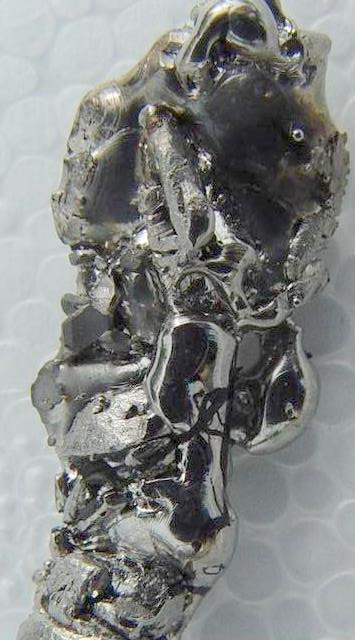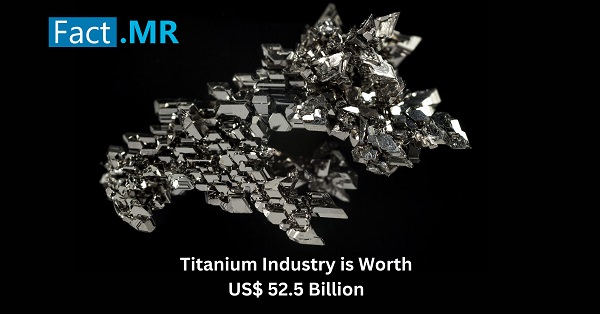Titanium Market Overview and Dynamics
Titanium, renowned for its remarkable strength and resistance to corrosion, occupies a pivotal role in the aerospace industry. Its utilization in crafting various components of aircraft, from fuselage structures to engine parts, underscores its indispensability. The market for titanium in aerospace components manufacturing is expected to increase steadily despite obstacles such price volatility and regulatory compliance. This is because the demand for novel aircraft parts is increasing and manufacturing innovation is continuing to advance.
The global Titanium market is expected to witness a market size of US $ 52.5 Bn by the end of 2033 and is predicted to witness a CAGR of 6.5%. The titanium market is witnessing significant growth in other sectors such as automotive, medical, and consumer electronics. Titanium is being used more and more in vehicle engineering for lightweighting projects meant to increase fuel economy and lower pollutants. Titanium implants are prized in the medical community for their ability to withstand corrosion and be biocompatible, which makes them perfect for a range of surgical uses. Since titanium is strong and stylish, the consumer electronics sector is using it in wearables, computers, and smartphones.
Key Drivers of the Titanium Market
- Demand for Lightweight Materials: Titanium’s exceptional strength-to-weight ratio makes it a sought-after choice in aerospace applications, enabling the construction of fuel-efficient aircraft with improved performance and reduced environmental impact. As the aviation industry prioritizes sustainability and cost-effectiveness, the demand for lightweight materials like titanium continues to rise.
- Advancements in Manufacturing: Innovations such as additive manufacturing (3D printing) have transformed the aerospace manufacturing landscape.With the ability to fabricate intricate titanium components with unprecedented precision and efficiency, additive manufacturing expands the possibilities for design optimization and customization. This enables aerospace engineers to push the boundaries of performance and efficiency, driving the adoption of titanium in various aircraft systems and structures. The advancements in traditional manufacturing processes further enhance the viability and affordability of titanium components, further driving their integration into next-generation aircraft platforms.

- Environmental Sustainability Initiatives: With increasing awareness of environmental issues and the need for sustainable practices, there is a growing emphasis on reducing carbon emissions and minimizing environmental impact across industries. Titanium’s lightweight properties contribute to fuel efficiency in aircraft, leading to reduced greenhouse gas emissions and a lower overall environmental footprint. As airlines and aerospace manufacturers prioritize sustainability goals, the demand for lightweight materials like titanium continues to escalate.
- Global Trends in Defense and Security: In addition to commercial aviation, the defense and security sectors are significant consumers of titanium for various applications, including military aircraft, naval vessels, and armored vehicles. With geopolitical tensions and security concerns driving defense spending worldwide, the demand for advanced materials like titanium remains robust. As defense budgets continue to grow, particularly in regions experiencing geopolitical instability, the aerospace industry benefits from increased orders for titanium components for military and security-related purposes.
Challenges Faced in the Titanium Industry
- Price Volatility: The titanium market is not immune to volatility, where prices can fluctuate in response to various factors. Disruptions in the supply chain, whether due to geopolitical tensions or natural disasters, can cause sudden spikes or drops in prices, affecting production costs and profit margins. Additionally, macroeconomic trends such as shifts in global demand or changes in currency values can also influence titanium prices, creating challenges for manufacturers and suppliers alike as they navigate uncertain market conditions.
- Regulatory Compliance: In the aerospace industry, strict adherence to regulatory standards is paramount to ensure the safety and reliability of aircraft. Meeting aviation regulations requires manufacturers to implement meticulous quality control measures and undergo rigorous certification processes for titanium components. This not only adds layers of complexity to the manufacturing endeavor but also introduces significant time constraints. From ensuring material integrity to verifying manufacturing processes, achieving regulatory compliance demands unwavering attention to detail and a commitment to upholding the highest standards of safety and quality.
Also Read: Thriving Lithium Industry Driving Clean Energy and Technological Innovation
Market Opportunities in the Titanium Business
- Advanced Titanium Alloys: The new types of titanium alloys are a big step forward in making airplanes better. These alloys are really good for building airplane parts because they’re stronger and last longer without breaking. They also resist damage better, like scratches and dents. This means that planes made with these alloys can be lighter and tougher, which helps them use less fuel and be safer to fly in tough conditions.
- Growth in Airplane Business: More people are flying, so there’s a big demand for new planes around the world. This is because more people have enough money to travel, and it’s easier to travel long distances by plane. Airplane companies are getting a lot of orders for new planes to meet this demand. And for each new plane, there’s a need for lots of different parts, many of which are made from titanium. Titanium is important for these parts because it helps make sure the planes are reliable, perform well, and, most importantly, are safe to fly. So, as the demand for new airplanes grows, does the need for titanium, making it a very important material in the airplane industry.
- Expanded Applications in Renewable Energy: Titanium’s exceptional properties extend beyond aerospace and into the realm of renewable energy. With the increasing focus on sustainability and the transition towards clean energy sources, titanium is emerging as a key material for various renewable energy technologies. In particular, titanium’s corrosion resistance and durability make it ideal for use in components such as wind turbine blades, solar panels, and hydrogen fuel cells. As the demand for renewable energy solutions continues to grow, so does the demand for titanium, presenting a significant opportunity for expansion into new markets and industries.
The advancements in titanium alloys and the booming growth of the airplane industry are shaping the future of aviation in exciting ways. With stronger, lighter, and more durable materials, aircraft are becoming more efficient and safer to fly, meeting the increasing demands of passengers worldwide.



